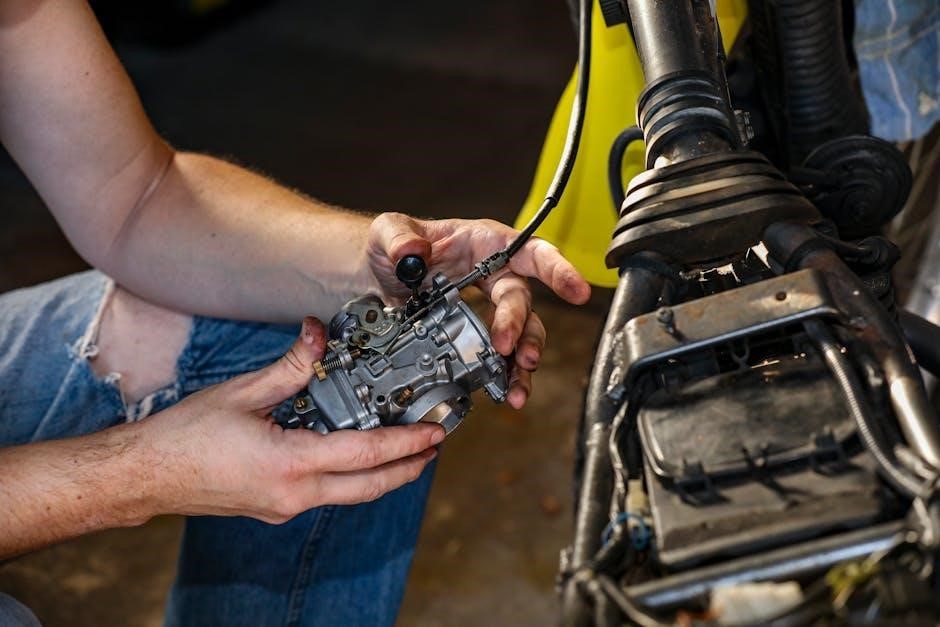
nys motorcycle permit manual pdf
The New York State Motorcycle Permit Manual (MV-21MC) is a comprehensive guide for aspiring motorcyclists, detailing road rules, safety regulations, and procedures for obtaining a permit and license. Available as a PDF, it ensures readiness for the motorcycle knowledge test while promoting safe riding practices. Reading it carefully is essential for understanding New York’s specific motorcycle laws and preparing for the written exam.
Overview of the NYS Motorcycle Permit Manual PDF
The NYS Motorcycle Permit Manual PDF (MV-21MC) is a detailed resource for motorcycle enthusiasts in New York. Divided into key sections, it covers motorcycle licenses, ownership rules, and essential safety practices. The manual is designed to help aspiring riders prepare for the written knowledge test and understand New York’s specific motorcycle laws. Available online, it serves as a practical guide for safe and legal motorcycling in the state.
Importance of the Manual for Aspiring Motorcyclists
The NYS Motorcycle Permit Manual is crucial for aspiring motorcyclists as it provides essential knowledge on road safety, traffic laws, and licensing requirements. The manual ensures riders understand New York-specific rules, promoting responsible and safe driving. It also serves as a key study resource for the motorcycle knowledge test, helping individuals pass with confidence while adhering to state regulations and safety standards.
Structure of the NYS Motorcycle Manual
The manual is divided into six main sections: Motorcycle Licenses, Ownership, Special Rules; Preparing to Ride; Riding Within Your Abilities; Being in Shape to Ride.
Each section provides detailed information to help motorcyclists understand the rules, safety practices, and legal requirements for operating a motorcycle in New York State.
Key Sections of the Manual
The manual’s key sections include motorcycle licenses, ownership, and special rules, providing essential information on obtaining a Class M or MJ license. It covers pre-ride preparations, riding techniques, and safety strategies to enhance road awareness. Additionally, the manual emphasizes the importance of physical and mental fitness for safe motorcycling, ensuring riders are well-prepared to handle various road conditions and emergencies effectively.
Chapter Highlights: From Licenses to Riding Techniques
The manual is divided into six main sections, starting with motorcycle licenses and ownership, followed by pre-ride preparations and riding strategies. It emphasizes understanding your bike’s capabilities and adhering to traffic laws. Later chapters focus on advanced riding techniques, such as cornering and braking, while also highlighting the importance of mental and physical readiness. These chapters provide practical advice for handling various road conditions and emergencies.

Eligibility Requirements for a Motorcycle Permit in NY
To qualify for a motorcycle permit in New York, applicants must meet age requirements, complete a motorcycle safety course if under 18, and pass a vision test.
Age Requirements and Documentation Needed
In New York, the minimum age to apply for a motorcycle permit is 16 years old. Applicants under 18 must provide parental consent and complete a motorcycle safety course. Required documents include a valid Social Security number, proof of identity, and residency. All applicants must pass a vision test and submit the necessary forms to the DMV. Proper documentation ensures eligibility for the permit process.
Medical and Vision Standards for Applicants
Applicants for a motorcycle permit in New York must meet specific medical and vision standards. Vision acuity must be at least 20/40 in each eye, with or without corrective lenses. Certain medical conditions may require evaluation by a licensed physician to ensure safe driving ability. The DMV assesses these standards to promote road safety and ensure applicants are physically and mentally capable of operating a motorcycle responsibly.
Application Process for a Motorcycle Permit
The New York DMV outlines a structured process for obtaining a motorcycle permit, requiring applicants to study the manual, pass a written test, and complete a vision exam.
Steps to Obtain a Motorcycle Permit in New York
To obtain a motorcycle permit in New York, applicants must first study the Motorcycle Operators Manual (MV-21MC). They then complete a written knowledge test and a vision exam at a DMV office. Upon passing, applicants provide required documentation, pay the permit fee, and receive their permit. The permit is valid for one year and allows practice riding under specific restrictions until the full license is obtained.
Written Test and Vision Test Procedures
The written test evaluates knowledge of motorcycle-specific traffic laws, road signs, and safety practices. Applicants must answer at least 80% of questions correctly. A vision test assesses visual acuity and peripheral vision. Both tests are conducted at DMV offices, with study materials available in the MV-21MC manual. Passing both tests is mandatory to qualify for a motorcycle permit in New York State.

Safety Guidelines and Best Practices
The manual emphasizes wearing helmets, protective gear, and practicing defensive driving. Regular motorcycle maintenance and pre-ride checks are also highlighted to ensure rider safety on New York roads.
Essential Safety Gear for Motorcyclists
The manual stresses the importance of wearing U.S. Department of Transportation-approved helmets, durable gloves, sturdy boots, and protective eyewear. It also recommends jackets and pants made from abrasion-resistant materials. Additionally, reflective gear is advised to enhance visibility, especially at night. Proper safety equipment significantly reduces injury risks and is a legal requirement in New York. Always ensure gear fits well and meets safety standards.

Pre-Ride Checks and Maintenance Tips
Before every ride, check tire pressure, brakes, headlights, and fluid levels. Ensure proper function of signals, mirrors, and suspension. Regularly inspect chain or belt wear and lubricate as needed. Maintain clean visibility by clearing dirt from lights and windshields. Always follow the manufacturer’s maintenance schedule. These checks ensure your motorcycle is road-ready, reducing the risk of mechanical failures and enhancing safety on the road.
Preparing for the Motorcycle Knowledge Test
Study the New York State Motorcycle Manual (MV-21MC) thoroughly. Utilize online practice tests to assess your knowledge. Focus on road signs, traffic laws, and safe riding practices to ensure success.
Study Materials and Practice Tests
The New York State Motorcycle Manual (MV-21MC) is the primary study resource for the knowledge test. It covers essential topics like road rules, safety practices, and motorcycle-specific laws. Additionally, the DMV offers online practice tests designed to simulate the actual exam format. These tools help applicants identify weak areas and improve their understanding of motorcycle safety and traffic regulations. Regular practice with these materials ensures better preparation and higher confidence for the test.
Focus Areas for the Written Exam
The written exam emphasizes motorcycle-specific traffic laws, road signs, and safe riding practices. Key areas include understanding New York’s unique motorcycle regulations, such as lane sharing and helmet requirements. Applicants should also focus on defensive driving techniques, pre-ride checks, and emergency maneuvers. Familiarity with road signs and signals is crucial, as is knowledge of alcohol and drug laws. Mastery of these topics ensures success on the motorcycle permit test in New York.
Traffic Laws and Road Rules for Motorcyclists
New York’s motorcycle laws emphasize safe riding practices, including lane sharing restrictions, mandatory helmet use, and maintaining a safe following distance. Motorcyclists must obey all traffic signals and signs, yielding the right-of-way as required. Familiarity with these rules is essential for legal and safe operation of a motorcycle in New York State.
Unique Motorcycle-Specific Traffic Laws in NY

New York has specific motorcycle traffic laws to enhance safety. Motorcyclists must wear approved helmets and eye protection. Handlebars cannot exceed shoulder height, and passengers require footrests and seats. Lane splitting is prohibited, and motorcyclists must use headlights during daylight. Additionally, motorcycles are banned from certain highways, and all riders under 21 must complete a safety course. These laws aim to reduce accidents and ensure safe coexistence with other vehicles.
Understanding Road Signs and Signals
Understanding road signs and signals is crucial for motorcyclists to navigate safely. The manual details various signs, including warning, regulatory, and guide signs, and explains traffic signals. Recognizing these is essential for obeying traffic laws, maintaining safety, and ensuring smooth traffic flow. Motorcyclists must be vigilant and knowledgeable to react appropriately to all road indicators.
Getting Your Full Motorcycle License
Obtaining a full motorcycle license in New York involves passing a skills test and paying the required fees, as outlined in the manual. This step ensures riders demonstrate their ability to operate safely and legally.
From Permit to Full License: The Process
Transitioning from a motorcycle permit to a full license in New York requires completing a motorcycle safety course or passing a DMV-administered road test. After holding the permit for at least six months, riders must demonstrate their riding skills and knowledge of traffic laws. Upon successful completion, the DMV issues the full motorcycle license, allowing unrestricted operation of motorcycles in New York State.
Skills Test and License Fees
The skills test assesses a rider’s ability to control and maneuver a motorcycle safely. Applicants must demonstrate proficiency in starting, stopping, turning, and shifting gears. The test also evaluates knowledge of traffic laws and safety practices. License fees vary, and applicants should check the DMV website for the most current information. The manual provides detailed preparation tips for the skills test to ensure success and compliance with New York State requirements.

Additional Resources for Motorcyclists

The NY DMV website offers downloadable resources, including the motorcycle manual (MV-21MC) and practice tests. Motorcycle safety courses and online guides provide further support for riders.
Online Resources and Motorcycle Safety Courses

The New York DMV website provides the Motorcycle Operators Manual (MV-21MC) in PDF format, along with practice tests to prepare for the written exam. Motorcycle Safety Foundation (MSF) courses are also available, offering hands-on training and safety tips. Online resources include guides on road signs, traffic laws, and defensive driving techniques. These tools are essential for new riders to gain confidence and skills before hitting the road.
NY DMV Website and Manual Downloads
The official New York DMV website offers the Motorcycle Operators Manual (MV-21MC) as a free PDF download, providing detailed information on state-specific motorcycle laws, safety guidelines, and license requirements. The website also features practice tests, application forms, and updates on motorcycle safety courses. Riders can access these resources to ensure they are well-prepared for both the written test and the road ahead.